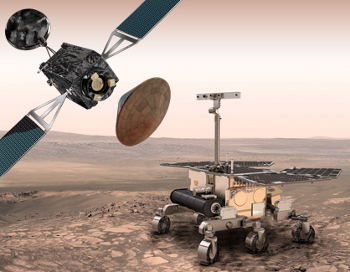Establishing if life ever existed on Mars is one of the outstanding scientific questions of our time. To address this important goal, the European Space Agency (ESA) has established the ExoMars programme to investigate the Martian environment and to demonstrate new technologies paving the way for a future Mars sample return mission in the 2020’s.
Two missions are foreseen within the ExoMars programme: one consisting of an Orbiter plus an Entry, Descent and Landing Demonstrator Module, to be launched in 2016, and the other, featuring a rover, with a launch date of 2018. Both missions will be carried out in cooperation with Roscosmos.
 |
|
Elements of the ExoMars programme 2016-2018 |
The ExoMars programme will demonstrate a number of essential flight and in-situ enabling technologies that are necessary for future exploration missions, such as an international Mars Sample Return mission. These include:
- Entry, descent and landing (EDL) of a payload on the surface of Mars;
- Surface mobility with a rover;
- Access to the subsurface to acquire samples; and
- Sample acquisition, preparation, distribution and analysis.
At the same time a number of important scientific investigations will be carried out, for example:
- Search for signs of past and present life on Mars;
- Investigate how the water and geochemical environment varies; and
- Investigate Martian atmospheric trace gases and their sources.
The 2016 mission includes a Trace Gas Orbiter (TGO) and an Entry, Descent and Landing Demonstrator Module (EDM). The Orbiter will carry scientific instruments to detect and study atmospheric trace gases, such as methane. The EDM will contain sensors to evaluate the lander’s performance as it descends, and additional sensors to study the environment at the landing site.
The 2018 mission includes a rover that will carry a drill and a suite of instruments dedicated to exobiology and geochemistry research.
Roscosmos will provide a Proton launcher for both missions.
